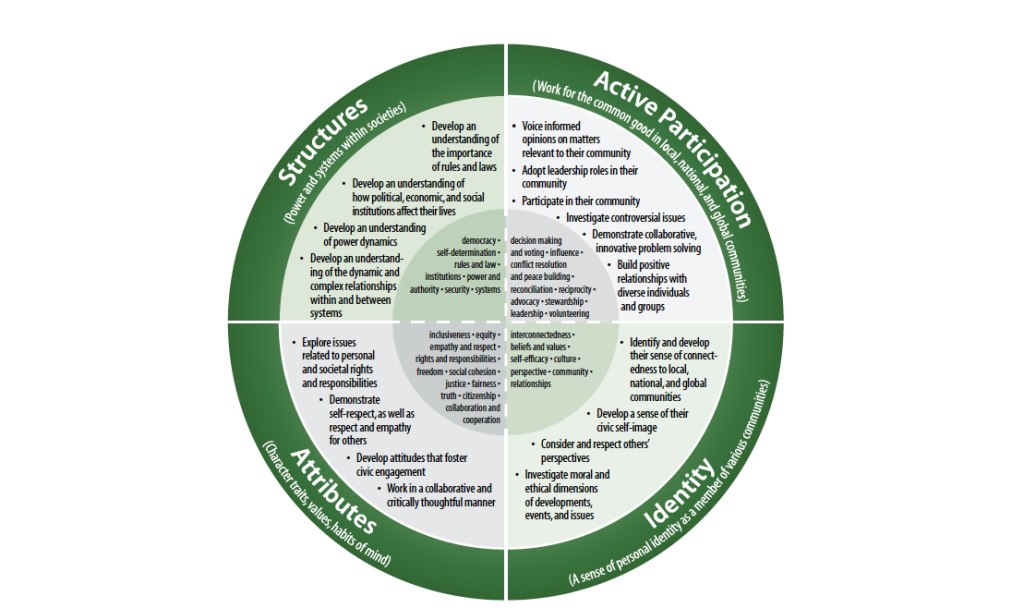Scholars such as Pinto (2012), among many others, have argued that “schools play an essential role in creating democratic societies” (p. 3) by providing Citizenship Education (CE) to develop young people’s understandings of democratic citizenship. Provincial CE curriculum guidelines and policies are intended to address citizenship in democratic societies by mandating what “students ought to learn and what teachers ought to teach” (Pinto, 2012, p. 4) about it.
To find out what the content of a mandated CE curriculum actually is, one must examine the curriculum learning outcomes (called “Overall expectations” and “Specific expectations” in the Ontario curriculum). These learning expectations are what teachers use to plan their teaching units and to outline what students will be expected to learn, which, for Citizenship Education, might include developing political capabilities which will reflect understanding of democratic values and governance.
In Canada, education falls under provincial and territorial jurisdiction, and as such, Citizenship Education curricula vary widely across the country. Many of the published research studies on Canadian CE have primarily focused on secondary school curricula, but a small number have addressed CE in the elementary panel (as I do here). Within these studies CE, GCE and global education (GE) tend to be used interchangeably, but in general, these can be viewed as including similar topics regarding the values and philosophy of democratic citizenship. Unfortunately, although recent steps have been made to include general, introductory, philosophical goals promoting CE, there is consistent evidence that the implementation of these goals remains limited (Bickmore, 2014), including in Ontario.
Citizenship Education in Ontario
A welcome development for Citizenship Education in Ontario occurred when a Citizenship Education Framework (CEF) was included within the main introduction to the Elementary Social Studies Curriculum document SS1-6 and HG7-8 [2013]. This same framework with a few additional concepts (figure 1) is also found in the revised 2018 curriculum document. It displays the curriculum’s espoused approach to CE in which concepts are divided into four main categories or “Main Elements” (outer circle), essential topics/values connected to citizenship are listed (innermost circle), and ways of developing the knowledge, skills and attitudes associated with these topics/values are described (middle circle).

Accompanying the circular graphic is a statement which reflects a philosophy that stresses the importance of initiating CE at an early age:
“In every grade and course in the social studies, history and geography curriculum, students are given opportunities to learn about what it means to be a responsible, active citizen in the community of the classroom and the diverse communities to which they belong within and outside the school.” (Ontario Ministry of Education)
The premise that CE initiates the “construction” of democratic thinking which can and should begin at an early age, is espoused by many Citizenship Education scholars. Empirical evidence suggests that very young children develop abstract categories of social relationships including stereotypes, allegiances and identities) and that cynicism about politics also starts at a young age (Sapiro 2004).
Why isn’t it working?
The Citizenship Education Framework (CEF) clearly includes terms/topics and KSA’s (knowledge, skills, attitudes) which represent relevant, democratic values; however, it is important to note that within Ontario classroom planning, teachers are not given any direction to become familiar with the CEF or to read the introduction at the front end of the document (e.g. within teacher education, in-service workshops, staff directives or supports).
With regard to the actual CE curriculum itself, i.e., the teaching expectations used by teachers to plan their lessons, the CE concepts and values of democratic citizenship laid out in the framework are embedded within the Specific Social Studies expectations, rather than included within Overall Expectations or as a designated strand. They are, therefore, not mandated to be taught, except in grade 5 where there is a designated strand on Government. It is within this context (how curriculum connects with classroom practice) that my analysis reveals significant gaps between what is espoused for CE within the framework, and what students will be expected to learn as per the teaching expectations that teachers use to design their units and plans of study.
Of the many concerns that came to light in the findings of this analysis, one that stands out immediately is that the concepts of both citizenship and democracy are completely marginalized. As well, although the term “common good” is used to define one of the main elements, it does not appear within any of the teaching expectations.
The concept of democracy itself, arguably one of the most important notions for CE in the Canadian context, is not addressed. As a term, democracy appears four times across all the expectations in the document; however, three of these expectations are purely historical and therefore not relevant to the CEF criteria which mandates the development of understanding citizenship within the context of students’ lives. Where the term democracy is included, it appears as a term inside a long list of other possible topics to be addressed.
No direction is offered for inquiry into the meaning or significance of the concept of democracy, the current form of governance in which we are meant to participate. An opportunity for teachers to make connections for students between related CE concepts such as, for example, conflict resolution and democracy, is alluded to in one specific expectation within the entire curriculum—a passing reference to democratic developments in Ancient Greece—but it does not connect students with opportunities to understand or practice constructive democratic deliberation about conflict and peacebuilding (Bickmore, 2014; Westheimer 2020), within their own contexts.
Democracy and freedom
Of the topics listed in the CEF considered integral to any democracy, the value of freedom— currently a very ‘hotly’ debated topic—is perhaps one of the core democratic values which, when misunderstood or misused, can threaten a healthy and flourishing democracy. It is a complex topic, requiring multiple levels of understanding. For example, in Canada, the use of the Charter of Rights and Freedoms’ ‘Notwithstanding Clause’ by provincial governments has been highly debated and seen as threatening to the rights and freedoms of citizens. As well, the federal government’s enactment of the Emergency Measures Act, used for the protection of the rights of those living in downtown Ottawa, was seen by others as a violation of the right to protest. In order for there to be informed deliberation, a clear understanding of all the aspects is required, e.g. the ‘Notwithstanding Clause’ only applies to certain sections of the Charter and cannot be used against provisions that protect the democratic process which would create a pathway to dictatorship; it can’t be used for more than five years at a time, ensuring that the public has the chance to challenge a government’s decision to use the clause in a general election before it can be renewed (Callaghan, 2022), etc.
Given the highly complex nature of the topic of freedom within a democracy, it could be argued that the development and implementation of school curricula, enabling students to participate in reasoned deliberation about the democratic rights and freedoms for which they will be voting, should be considered crucial for the sustainability of democratic governance going forward. Students in grades 6, 7 and 8 are fully capable of developing understanding and building their capabilities for deliberation on the core values of democratic citizenship and should be given opportunities to do so.
Freedom and Inclusive Citizenship
Within the current Ontario Citizenship Education curriculum, the term ‘freedom’ is used in one grade 6 specific expectation; it is also listed in the introduction for this grade as one of the concepts from the CEF that students could be given the opportunity to explore—a happy alignment! Unfortunately, the chances that this one specific expectation will be used by teachers is ad hoc—they might incorporate it within their teaching units, but they might not. Nonetheless, a closer look at this expectation does give us a window into the ways in which teachers who do choose to implement it could begin to initiate understanding of freedom and inclusive citizenship within democracy.
Teachers and students are encouraged to make connections between inclusiveness within individual communities as it relates to personal identity and to freedom of choice. They are asked to consider the question: “Do you think that Canadian society allows for your community to make a meaningful contribution to identities in Canada? Why or why not?” However, if students conclude that Canadian society does not allow for their community to make “meaningful contributions” to identities in Canada, or if they have questions about what might constitute “meaningful contributions”, many other essential CE topics would potentially need to be explored: equity, justice, fairness, truth, conflict and peacebuilding, collaboration and cooperation, rules and law. But as the findings of my analysis show, these topics are not included within any curriculum expectations.
Students would need to be given opportunities to understand concretely and actively how it is, specifically, that they will have the opportunities to make meaningful contributions, through various kinds of cooperative civic engagement and democratic participation. Ultimately, within the context of this one specific expectation that may or may not be implemented, chances are very limited for providing students with the hope that they will indeed be given opportunities “to learn about what it means to be a responsible, active citizen” through meaningful contributions that will effect change.
As with the concepts of democracy and freedom, citizenship and the common good are alluded to, but in terms of developing understanding, there is only one expectation in the entire curriculum that explicitly refers to the concept of citizenship and to what is meant by good citizenship. The concept of the common good does not appear in any teaching expectation, at all.
The omission of these and other fundamental inter-related CE terms and topics from the curriculum expectations, as well as the sporadic and haphazard distribution of CE concepts across the curriculum, completely diminishes opportunities for students to make connections between CE and their personal identities as members of a democratic citizenry.
Conclusion
This issue of a ‘policy-practice gap’ in Citizenship Education has been identified by many CE scholars as widespread. In this specific example of the Ontario CE curriculum, it is evident that one of the reasons for a policy-practice gap is that the teaching ‘expectations’ which teachers use to plan their lessons actually contain only a very limited amount of the CE curriculum that is outlined in the introduction to this curriculum.
Is it possible that if, in every grade, students were given a required minimum of weekly ‘practice’ in analysing, synthesizing and evaluating the application of democratic values to appropriate current political contexts, this might ensure more effective outcomes for CE and, ultimately, for democracy going forward?
We can teach students that we have choices about the ways we organize our lives, socially, economically, and politically. But to do so, educators must be enabled and encouraged to include those goals in the fabric of the school curriculum… (Westheimer, 2020, p.12)
The “fabric” of school curricula lies in the teaching ‘expectations’ themselves and this is where we must make the changes that will improve outcomes for Citizenship Education which will contribute to building trust for students that their democratic government can and will find solutions for the common good, and that it is their right and responsibility to participate in making the changes that are so urgently needed. Ultimately, if education is not able to contribute to democratic citizenship in this way, then, as Maria Ressa (2022) has suggested, we may be in danger of forgetting that democracies can and have been “crush[ed]…from within.
This article is based on a much longer analysis completed for a Major Research Paper within the MEd program at University of Ottawa. It has been edited to focus on how the Ontario Citizenship Education curriculum addresses the concepts of freedom and citizenship in a democratic society. The full study can be made available upon request by reaching out to sheila.stevens@rogers.com.







